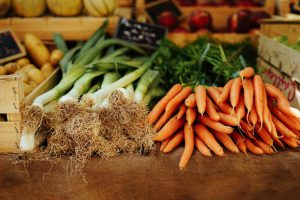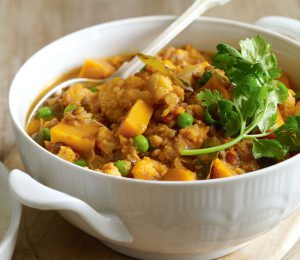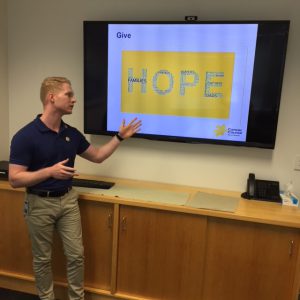On this page you will find information on:
Australia’s Biggest Morning Tea is on its way

This year thousands of Queenslanders across the state will gather in living rooms, cafes, workplaces and community halls to raise their cups in celebration of 25 years of Australia’s Biggest Morning Tea.
Over the past 25 years, $31.2 million has been raised for Cancer Council Queensland by like-minded individuals hosting a morning tea to make a difference.
We’d love you to join the celebration and host your own morning tea or spread the word in your local community.
Register now to receive your host pack of goodies including decorations, fundraising tips and recipes to make your morning tea a success!
Our official 2018 merchandise is also here – and looking better than ever! Purchase snazzy mugs, stylish aprons, tea towels and tea tins to spruce up your event.
Every cuppa poured and dollar raised enables us to continue investing in lifesaving cancer research, prevention, advocacy and support programs.
Visit biggestmorningtea.com.au to register or find out more.
Meet Vaishnavi Nathan, Donor Care Correspondent
What is your role with CCQ? What does it involve?
My role is Donor Care Correspondent. This involves writing notes and cards to the lovely, generous donors at Cancer Council Queensland.
Tell us a little bit about yourself
I’m a PhD Student studying melanoma, in particular, familial melanoma, at the Queensland Institute of Medical Research (QIMR Berghofer). I love what I do and can’t wait to see the results from my PhD project.
Why did you decide to get involved with CCQ? What was your motivation for volunteering?
Cancer Council have played such an integral role in medical research and patient support; it was an easy decision to get involved and give back to the community in a different aspect. Being a researcher and working in the lab is so rewarding and exciting, and it’s important to me to remind myself why as a researcher I do what I do.
Speaking to those affected by this awful disease, hearing their stories and knowing the reasons behind their support is of extreme significance to me. As a scientist, my goal is to significantly contribute to this field of research by understanding more about melanoma, and ultimately help all those who have, or will be affected, by cancer.
What do you love most about your volunteer role?
What I’ve loved most has been getting to know the great Donor Development Team. Leanne, Jenna and Helen are so passionate and enthusiastic about their work, and being in such a positive environment is inspiring and fulfilling.
What has surprised you in your role?
What has surprised me most about my role has been just how open and generous people can be. Generosity, not just with their donation but with their story and experience, has been an absolute privilege to witness so far.
What has been the most inspiring or memorable moment you’ve had since starting with CCQ?
I was shown a beautiful letter written by an amazing young girl who had corresponded with Cancer Council Queensland a while back. She had decided to donate her pocket money to CCQ, and took the time to write a thoughtful and heartfelt letter. That was very special for the team to share with me, and I was extremely inspired by the young girl.
What is your hope for the future? What do you hope your volunteering will achieve for cancer and CCQ?
Cancer is such a complex disease, so my hope for the future is for scientists and clinicians to be able to understand it so well that we can fight it with all we’ve got. I hope we find better, preventative methods, improved diagnostic tools, successful treatments, and be able to improve quality of care and life for cancer patients. I hope my volunteering will help communicate the importance of organisations such as Cancer Council Queensland.
What would you say to someone who was thinking about volunteering with CCQ?
Go for it, it’s a great decision!
What do you feel you’ve gained through volunteering for CCQ?
I’ve gained insight into the workings of this great organisation, and experience with communicating with donors on a personal level.
Find your fibre

Dietary fibre is an important part of a healthy diet, helping to prevent heart disease, diabetes and bowel cancer. Recent data suggests that 18 per cent of bowel cancer cases could be prevented if we ate enough dietary fibre.
Australian guidelines recommend that women consume 25g of dietary fibre each day, and men 30g. Yet the average Queenslander falls about 5g short. With this in mind, we’re answering common questions and providing tips to help you get on the road to enjoying fibre every day.
What is dietary fibre?
Dietary fibre is the part of plant foods, such as vegetables, fruits, wholegrains, legumes, nuts and seeds, that cannot be digested in the stomach or small intestine. Instead, it passes relatively unchanged into the large intestine where it is fermented by friendly bacteria. There are two main types of fibre – insoluble fibre from the skin of fruits, vegetables and nuts; and soluble fibre from oats, legumes and the flesh of fruits and vegetables.
What does dietary fibre do?
Insoluble fibre adds bulk to the contents of our digestive system which helps to keep our bowels regular. Soluble fibre forms a thick gel in our intestines which slows our digestion and helps to bind substances like glucose and lipids. In turn, this can help to control our blood glucose levels and lower our LDL (unhealthy) cholesterol.
Fibre helps to reduce cancer risk in four ways:
- Binds carcinogens to the stool and expels them from the body.
- Good bacteria in the colon convert fibre into short-chain fatty acids. Short-chain fatty acids reduce the ability of cells in the intestine to become cancerous.
- By helping us to feel fuller for longer, fibre plays a key role in maintaining a healthy weight.
- Reducing absorption of carbohydrates into the blood reduces insulin resistance, therefore reducing the risk of some cancers.
How can I get more in my diet?
Most Queenslanders only need 5g more dietary fibre in a day to meet their requirements. You can get 4-6g of dietary fibre in:
- 1 cup of cooked vegetables
- 2 cups of salad vegetables
- 1 large apple, banana or orange
- 1 cup of cooked rolled oats, wholemeal pasta or quinoa
- 4 wheat biscuits
- 2 slices of wholemeal bread
Have tummy issues that stop you from eating some of these foods? Consider seeing an Accredited Practicing Dietitian who can help find ways to incorporate fibre into your everyday life without triggering stomach (or worse!) upsets. Find an APD close to you at https://daa.asn.au/find-an-apd/
Cauliflower, lentil & pumpkin curry

17g dietary fibre per serve – serves 4 – ready in 60 minutes
1 tbsp olive oil
1 brown onion, finely chopped
3 tbsp mild curry paste
12 fresh curry leaves
1 tbsp finely grated ginger
400g can diced tomatoes
1 ½ cups (375ml) water
1 cup (105g) lentils (red or brown), rinsed
600g butternut pumpkin, seeded, cut into 3cm pieces
1/2 (about 600g) cauliflower, cut into florets
1 cup (150g) frozen peas
Coriander leaves, to serve and 2 cups of quinoa
- Heat oil in a large saucepan over medium heat. Add onion and cook, stirring, for 3 minutes or until onion softens. Add curry paste, curry leaves and ginger and cook, stirring, for 1 minute or until aromatic. Add tomatoes and water and bring to a simmer.
- Add lentils and cook, stirring occasionally, for 15 minutes or until lentils are almost tender. Add the pumpkin and cauliflower and cook, stirring occasionally, for a further 10 minutes or until pumpkin is tender. Add peas and stir to combine. Remove from heat. Taste and season with salt and pepper.
- Spoon curry among serving bowls and sprinkle with coriander, serve with quinoa
Become a CCQ Champion!

Do you have a passion for public speaking or would like to share our vision more widely? Represent us at community expos and events!
CCQ Champion Community Representative – Community Engagement
Statewide
Share your passion for a cancer free future. As a charity, we work with and for the community across all cancers, for everyone affected by or concerned about cancer. By becoming a Community Representative, you can help share our vision by representing us at community expos and events. The role involves attending events, speaking to community members about our work and, if appropriate, referring people to the relevant programs and services.
CCQ Champion Community Speaker – Community Engagement
Statewide
Do you have a passion for public speaking? Join us a Community Speaker and help promote our work in your local community. The role involves presenting at workplaces, community groups and fundraising events about cancer prevention, research and patient support services as well as inspiring the community to get involved with our work. Full training and presentation resources about Cancer Council Queensland are provided to help keep our message consistent. If you are outgoing, enthusiastic and as passionate about a cancer free future as we are.
To apply please visit our volunteer opportunities page or call us on 1300 851 967.
